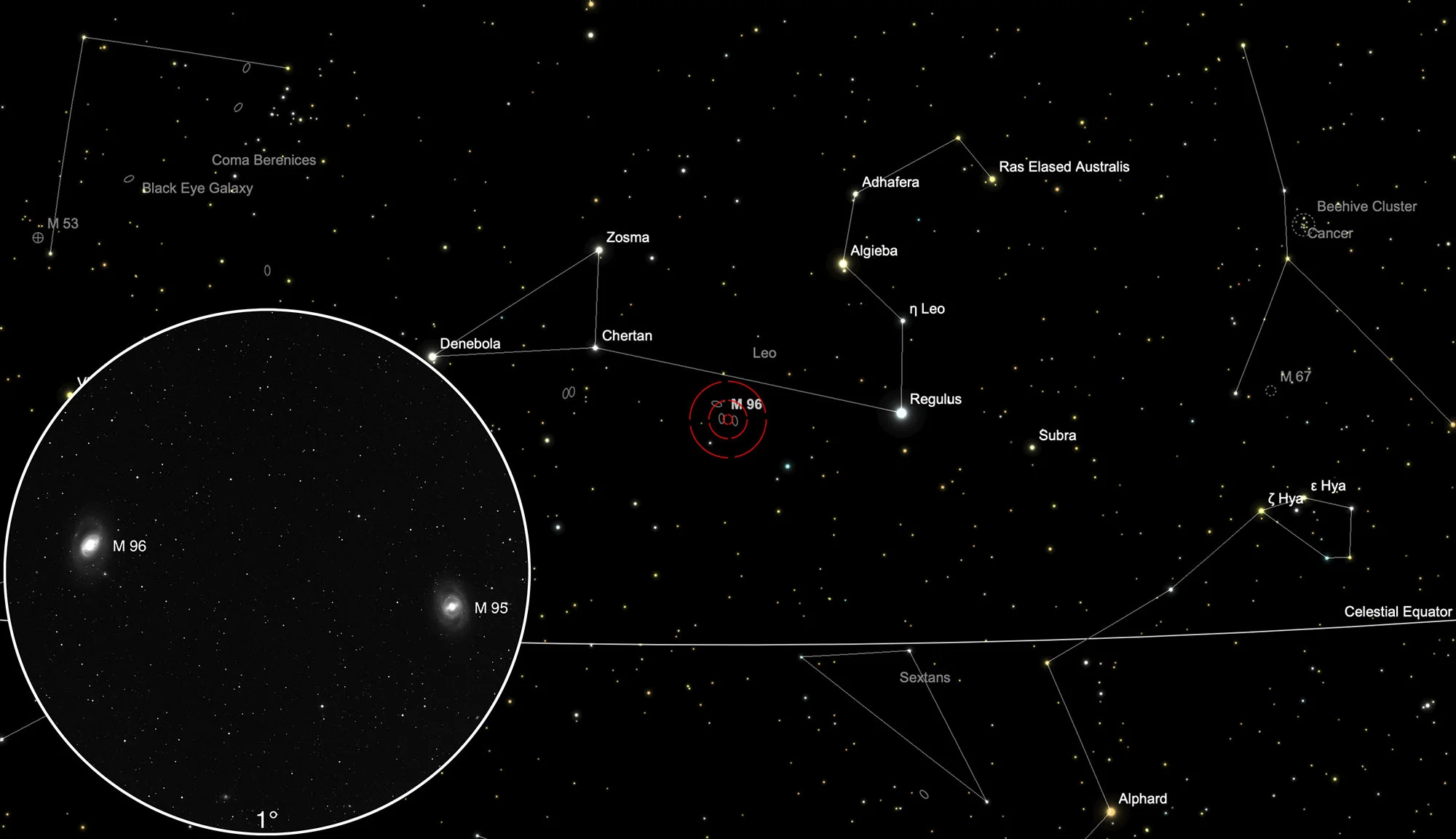Galaxies Messier 95 & Messier 96
History
M 95 and M 96 were discovered by Pierre Méchain on 20 March 1781 and cataloged by Charles Messier on the 24th of the same month. He wrote about M 95: «Nebula without a star, in Leo, above star 1: the light is very weak.» About M 96 he wrote: «Nebula without a star, in Leo, next to the previous one; this is less obvious, both are on the parallels of Regulus: they resemble the two nebulae nos. 84 and 86 in Virgo. M. Méchain had seen both of them on 20 March 1781.» [281]

Physical Properties of M 95
M 95 is a beautiful barred spiral galaxy and has around 40 billion stars. It is located about 33 million light years away and belongs to the Leo I group of galaxies, which includes M 95, M 105 and a large number of other galaxies. Many young, blue stars appear in the spiral arms. They are tightly wound around the centre of the galaxy and are almost circular. In March 2016, the supernova SN 2012aw was discovered in the outer spiral arms of this galaxy. The star that became a supernova was a large, red supergiant with 26 times the mass of our sun. [196, 215]
| Designation | NGC 3351 |
| Type | Gx (SBb) |
| Right Ascension (J2000.0) | 10h 43m 57.8s |
| Declination (J2000.0) | +11° 42' 12" |
| Diameter | 7.4 × 5 arcmin |
| Photographic (blue) magnitude | 10.5 mag |
| Visual magnitude | 9.7 mag |
| Surface brightness | 13.5 mag·arcmin-2 |
| Position Angle | 13° |
| Redshift (z) | 0.002595 |
| Distance derived from z | 10.96 Mpc |
| Metric Distance | 10.110 Mpc |
| Dreyer Description | B, L, R, pgmbMN |
| Identification, Remarks | WH I 26; h 743; GC 2184; M 95; UGC 5850; MCG 2-28-1; CGCG 66-4; IRAS 10413+1158 |
Physical Properties of M 96
What is remarkable about the spiral galaxy M 96 is that its core is not exactly in the galactic centre. It's about 35 million light years away. Mass and size roughly correspond to those of our Milky Way. [215]
In the eastern part of the galaxy we look through the spiral arms to the distant galaxy 2MFGC 08391 with extreme edge position. Due to the expansion of the universe, it is moving away at a speed of 16'530 km/s, which corresponds to a distance of about 244 Mpc (796 million light years). [194]


| Designation | NGC 3368 |
| Type | Gx (SBab) |
| Right Ascension (J2000.0) | 10h 46m 45.8s |
| Declination (J2000.0) | +11° 49' 12" |
| Diameter | 7.8 × 5.2 arcmin |
| Photographic (blue) magnitude | 10.1 mag |
| Visual magnitude | 9.3 mag |
| Surface brightness | 13.1 mag·arcmin-2 |
| Position Angle | 176° |
| Redshift (z) | 0.002992 |
| Distance derived from z | 12.64 Mpc |
| Metric Distance | 10.860 Mpc |
| Dreyer Description | vB, vL, lE, vsvmbM, r |
| Identification, Remarks | h 749; GC 2194; M 96; UGC 5882; MCG 2-28-6; CGCG 66-13; IRAS 10441+1205 |
Finder Chart
The two galaxies are located in the constellation Leo, about two degrees south on the centre of the connecting lines of the two stars Chertan (θ Leonis) and Regulus (α Leonis). Almost one degree northeast of galaxy M 96 is the triple galaxy group M 105, NGC 3384, NGC 3389.
Visual Observation
The two galaxies are clearly visible with a smaller telescope. With an average brightness of 10.5 mag, they are not too much of a challenge. However, they are all the more clear and brighter. Unfortunately, none of the four galaxies give off any structures and the fine spiral arms at M 95 and M 96 are only visible on larger telescopes. — Eduard von Bergen [192]
400 mm Aperture: Even at higher magnification (9 mm Nagler, 200x), both galaxies only appear as structureless ovals with a bright core. — 400 mm f/4.5 Taurus Dobsonian, Hasliberg, SQM 21.2, 3. 2. 2024, Bernd Nies
